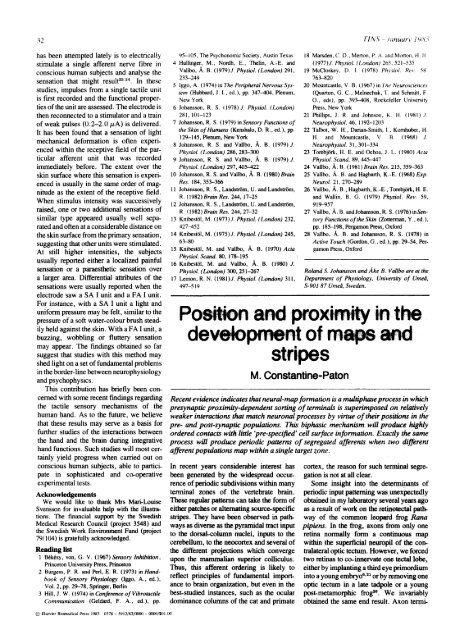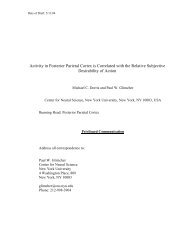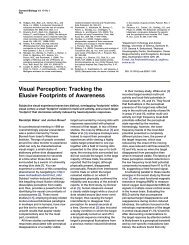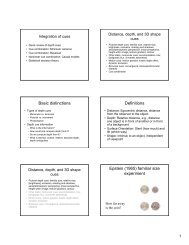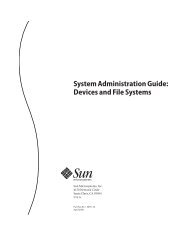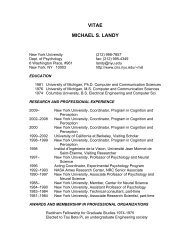Tactile sensory coding in the glabrous skin of the human hand
Tactile sensory coding in the glabrous skin of the human hand
Tactile sensory coding in the glabrous skin of the human hand
Create successful ePaper yourself
Turn your PDF publications into a flip-book with our unique Google optimized e-Paper software.
32<br />
has been attempted lately is to electrically<br />
stimulate a s<strong>in</strong>gle afferent nerve fibre <strong>in</strong><br />
conscious <strong>human</strong> subjects and analyse <strong>the</strong><br />
sensation that might result ~a24. In <strong>the</strong>se<br />
studies, impulses from a s<strong>in</strong>gle tactile unit<br />
is first recorded and <strong>the</strong> functional proper-<br />
ties <strong>of</strong> <strong>the</strong> unit are assessed. The electrode is<br />
<strong>the</strong>n reconnected to a stimulator and a tra<strong>in</strong><br />
<strong>of</strong> weak pulses (0.2-2.0/zA) is delivered.<br />
It has been found that a sensation <strong>of</strong> light<br />
mechanical deformation is <strong>of</strong>ten experi-<br />
enced with<strong>in</strong> <strong>the</strong> receptive field <strong>of</strong> <strong>the</strong> par-<br />
ticular afferent unit that was recorded<br />
immediately before. The extent over <strong>the</strong><br />
sk<strong>in</strong> surface where this sensation is experi-<br />
enced is usually <strong>in</strong> <strong>the</strong> same order <strong>of</strong> mag-<br />
nitude as <strong>the</strong> extent <strong>of</strong> <strong>the</strong> receptive field.<br />
When stimulus <strong>in</strong>tensity was successively<br />
raised, one or two additional sensations <strong>of</strong><br />
similar type appeared usually well sepa-<br />
rated and <strong>of</strong>ten at a considerable distance on<br />
<strong>the</strong> sk<strong>in</strong> surface from <strong>the</strong> primary sensation,<br />
suggest<strong>in</strong>g that o<strong>the</strong>r units were stimulated.<br />
At still higher <strong>in</strong>tensities, <strong>the</strong> subjects<br />
usually reported ei<strong>the</strong>r a localized pa<strong>in</strong>ful<br />
sensation or a paraes<strong>the</strong>tic sensation over<br />
a larger area. Differential atlributes <strong>of</strong> <strong>the</strong><br />
sensations were usually reported when <strong>the</strong><br />
electrode saw a SA I unit and a FA I unit.<br />
For <strong>in</strong>stance, with a SA I unit a light and<br />
uniform pressure may be felt, similar to <strong>the</strong><br />
pressure <strong>of</strong> a s<strong>of</strong>t water-colour brush stead-<br />
ily held aga<strong>in</strong>st <strong>the</strong> sk<strong>in</strong>. With a FA I unit, a<br />
buzz<strong>in</strong>g, wobbl<strong>in</strong>g or fluttery sensation<br />
may appear. The f<strong>in</strong>d<strong>in</strong>gs obta<strong>in</strong>ed so far<br />
suggest that studies with this method may<br />
shed light on a set <strong>of</strong> fundamental problems<br />
<strong>in</strong> <strong>the</strong> border-l<strong>in</strong>e between neurophysiology<br />
and psychophysics.<br />
This contribution has briefly been con-<br />
cerned with some recent f<strong>in</strong>d<strong>in</strong>gs regard<strong>in</strong>g<br />
<strong>the</strong> tactile <strong>sensory</strong> mechanisms <strong>of</strong> <strong>the</strong><br />
<strong>human</strong> <strong>hand</strong>. As to <strong>the</strong> future, we believe<br />
that <strong>the</strong>se results may serve as a basis for<br />
fur<strong>the</strong>r studies <strong>of</strong> <strong>the</strong> <strong>in</strong>teractions between<br />
<strong>the</strong> <strong>hand</strong> and <strong>the</strong> bra<strong>in</strong> dur<strong>in</strong>g <strong>in</strong>tegrative<br />
<strong>hand</strong> functions. Such studies will most cer-<br />
ta<strong>in</strong>ly yield progress when carried out on<br />
conscious <strong>human</strong> subjects, able tO partici-<br />
pate <strong>in</strong> sophisticated and co-operative<br />
experimental tests.<br />
Acknowledgements<br />
We would like to thank Mrs MargLouise<br />
Svensson for <strong>in</strong>valuable help with <strong>the</strong> illustra-<br />
tions. The f<strong>in</strong>ancial support by <strong>the</strong> Swedish<br />
Medical Research Council (project 3548) and<br />
<strong>the</strong> Swedish Work Envirorm~nt Fund (project<br />
79/104) is gratefully acknowledged.<br />
Read<strong>in</strong>g list<br />
1 B6k~,sy, van, G. V. (1967) Sensory Inhibition,<br />
Pr<strong>in</strong>ceton University Press, Pr<strong>in</strong>ceton<br />
2 Burgess, P. R. and Perl, E. R. (1973) <strong>in</strong>Hand-<br />
book <strong>of</strong> Sensory Physiology (lggo, A., ed.),<br />
Vol. 2, pp. 29-78, Spr<strong>in</strong>ger, Berl<strong>in</strong><br />
3 Hill, J. W. (1974) <strong>in</strong> Conference <strong>of</strong> Vibrotactile<br />
Communication (Geldard, F. A., ed.), pp.<br />
Elsevier Biomedical Press 1983 0378 - 5912/83/000~3 - 00001501 00<br />
95-105, The Psychonomic Society, Aust<strong>in</strong> Texas<br />
4 Hull<strong>in</strong>ger, M., Nordh, E., Thel<strong>in</strong>, A.-E. and<br />
Valibo, ,~. B. (1979)J. Physiol. (London) 291,<br />
233-249<br />
5 Iggo, A. (1974) <strong>in</strong> The Peripheral Nervous Sys-<br />
tem (Hubbard, J. I., ed.), pp. 347---404, Plenum,<br />
New York<br />
6 Johansson, R. S. (1978)J. Physiol. (London)<br />
281,101-123<br />
7 Johansson, R. S. (1979) <strong>in</strong>Sensory Functions <strong>of</strong><br />
<strong>the</strong> Sk<strong>in</strong> <strong>of</strong> Humans (Kenshalo, D. R., ed.), pp.<br />
129-145, Plenum, New York<br />
8 Johansson, R. S. and Vatlbo, ./~. B. (1979)J.<br />
Physiol. (London) 286, 283-300<br />
9 Johansson, R. S. and Vallbo, /~. B. (1979)J.<br />
Physiol. (London) 297,405--422<br />
10 Johansson, R. S. and Vallbo, /~. B. (1980) Bra<strong>in</strong><br />
Res. 184, 353-366<br />
11 Johansson, R. S., Landstr6m, U. and Lundstr6m,<br />
R. (1982)Bra<strong>in</strong> Res. 244, 17-25<br />
12 Johansson, R. S., Landstr6m, U. and Lundstr6m,<br />
R (1982)Bra<strong>in</strong> Res. 244, 27-32<br />
13 Knihest61, M. (1973)J. Physiol. (London) 232,<br />
427-452<br />
14 Knibest61, M. (1975)J. Physiol. (London) 245,<br />
63-80<br />
15 Knibest61, M. and Vallbo, /~. B. (1970) Acta<br />
Physiol. Scand. 80, 178-195 i<br />
16 Knibest61, M. and Vallbo, ,~. B. (1980)J.<br />
Physiol. (London) 300, 251-267<br />
17 Lemon, R. N. (1981)J. Physiol. (London) 311,<br />
497-519<br />
18 Marsden, C. D., Merton, P. A. and Morton, H. i3<br />
(1977)J. Physiol. (London) 265,521--535<br />
19 McCIoskey, D. 1. (1q78) Phi'sial. Re~' 58<br />
76:3-820<br />
20 Mountcastle, V. B. (1967) <strong>in</strong> ltw Neurosciences<br />
(Quarton, G. C., Melnechuk, T and Schmitt, F<br />
O., eds), pp. 39.3-408, Rockefeller University<br />
Press, New York<br />
21 Phillips, J. R. and Johnson, K. H. (1981).L<br />
Neurophysiol. 46, 1192-1203<br />
22 Talbot, W. H., Darian-Smith, I, Komhuber, H.<br />
H. and Mountcastle, V. B. (1968) J.<br />
Neurophysiol. 3 I, 301-334<br />
23 Tombj6rk, H. E. and Ochoa, J. L. (19801Acta<br />
Physiol. Scand. 89, 445-447<br />
24 Vallbo,/~. B. (1981)Bra<strong>in</strong> Res. 215,359-363<br />
25 Vallbo, /~. B. and Hagbarth, K.-E. (1968)Exp.<br />
Neural. 21,270-289<br />
26 Vallbo,/~. B., Hagbarth, K.-E., Torebj6rk, H. E.<br />
and Wall<strong>in</strong>, B. G. (1979) Physiol. Rev. 59,<br />
919-957<br />
27 Vallbo,/k. B. andJohansson, R. S. (1976) <strong>in</strong>Sen-<br />
sory Functions <strong>of</strong> <strong>the</strong> Sk<strong>in</strong> (Zotterman, Y., ed.),<br />
pp. 185-198, Pergamon Press, Oxford<br />
28 Vallbo, /~. B. and Johansson, R. S. (1978) <strong>in</strong><br />
Active 7buch (Gordon, G., ed. ), pp. 29-54. Per-<br />
gamon Press, Oxford<br />
Roland S. Johansson and ke B. Vallbo are at <strong>the</strong><br />
Department <strong>of</strong> Physiology, University <strong>of</strong> Ume~,<br />
S-901 87 Urned, Sweden.<br />
Po-s;'tion and proximity <strong>in</strong><br />
deve nt <strong>of</strong><br />
stripes<br />
M. Constant<strong>in</strong>e-Paton<br />
Recent evidence <strong>in</strong>dicates that neural-map formation is a multiphase process <strong>in</strong> which<br />
presynaptic proximity-dependent sort<strong>in</strong>g <strong>of</strong> term<strong>in</strong>als is superimposed on relatively<br />
weaker <strong>in</strong>teractions that match neuronal processes by virtue <strong>of</strong> <strong>the</strong>ir positions <strong>in</strong> <strong>the</strong><br />
pre- and post-synaptic populations. This biphasic mechanism will produce highly<br />
ordered contacts with little 'pre-specified' cell surface <strong>in</strong>formation. Exactly <strong>the</strong> same<br />
process will produce periodic patterns <strong>of</strong> segregated afferents when two different<br />
afferent populations map with<strong>in</strong> a s<strong>in</strong>gle target zone.<br />
In recent years considerable <strong>in</strong>terest has<br />
been generated by <strong>the</strong> widespread occur-<br />
rence <strong>of</strong> periodic subdivisions with<strong>in</strong> many<br />
term<strong>in</strong>al zones <strong>of</strong> <strong>the</strong> vertebrate bra<strong>in</strong>.<br />
These regular patterns can take <strong>the</strong> form <strong>of</strong><br />
ei<strong>the</strong>r patches or alternat<strong>in</strong>g source-specific<br />
stripes. They have been observed <strong>in</strong> path-<br />
ways as diverse as <strong>the</strong> pyramidal tract <strong>in</strong>put<br />
to <strong>the</strong> dorsal-column nuclei, <strong>in</strong>puts to <strong>the</strong><br />
cerebellum, to <strong>the</strong> neoeortex and several <strong>of</strong><br />
<strong>the</strong> different projections which converge<br />
upon <strong>the</strong> mammalian superior colliculus.<br />
Thus, this afferent order<strong>in</strong>g is likely to<br />
reflect pr<strong>in</strong>ciples <strong>of</strong> fundamental import-<br />
ance to bra<strong>in</strong> organization, but even <strong>in</strong> <strong>the</strong><br />
best-studied <strong>in</strong>stances, such as <strong>the</strong> ocular<br />
dom<strong>in</strong>ance columns <strong>of</strong> <strong>the</strong> cat and primate<br />
cortex, <strong>the</strong> reason for such term<strong>in</strong>al segre-<br />
gation is not at all clear.<br />
Some <strong>in</strong>sight <strong>in</strong>to <strong>the</strong> determ<strong>in</strong>ants <strong>of</strong><br />
periodic <strong>in</strong>put pattern<strong>in</strong>g was unexpectedly<br />
obta<strong>in</strong>ed <strong>in</strong> my laboratory several years ago<br />
as a result <strong>of</strong> work on <strong>the</strong> ret<strong>in</strong>otectal path-<br />
way <strong>of</strong> <strong>the</strong> common leopard frog Rana<br />
pipiens. In <strong>the</strong> frog, axons from only one<br />
ret<strong>in</strong>a normally form a cont<strong>in</strong>uous map<br />
with<strong>in</strong> <strong>the</strong> superficial neuropfl <strong>of</strong> <strong>the</strong> con-<br />
tralateral optic tectum. However, we forced<br />
two ret<strong>in</strong>as to co-<strong>in</strong>nervate one tectal lobe,<br />
ei<strong>the</strong>r by implant<strong>in</strong>g a third eye primordium<br />
<strong>in</strong>to a young embryo s. 21 or by remov<strong>in</strong>g one<br />
optic tecturn <strong>in</strong> a late tadpole or a young<br />
post-metamorphic frog aa. We <strong>in</strong>variably<br />
obta<strong>in</strong>ed <strong>the</strong> same end result. Axon terrm-


